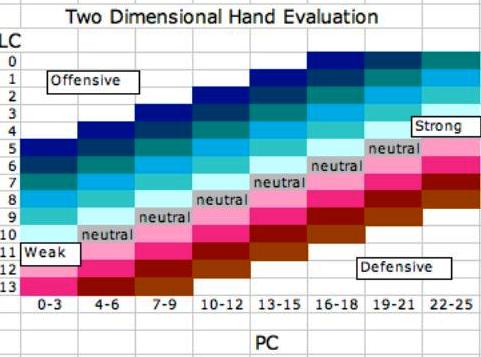Source: Two Dimensional Bridge hand evaluation
Have you ever wondered how the bridge experts always seem to know when to stretch in the bidding and when to be conservative? The rest of the field has overbid and the expert hasn’t? What does it means when the expert pair describes their bidding as “occasional light opening”? What “occasion” are they talking about? This discussion covers the basics of a reliable technique that will allow average bidders to know when to bid aggressively and when to bid conservatively.
The secret is to be able to assess both the offensive strength (How valuable is this hand if our side wins the contract?) and the defensive strength (How valuable is my hand if the opponents win the contract?) If the hand is worth more in offensive terms than defensive terms then you should bid it aggressively. If the hand’s strength is primarily defensive
then you should allow the opponents to overbid. The expert can look at a bridge hand and instinctively know the balance between offensive value and defensive value. What follows is a tool that will allow the novice to do this same evaluation.
The Two Metrics
The first metric is the normal Point Count (PC): Ace=4, King=3, Queen=2, Jack=1, doubleton=1, singleton=2, void=3.
The second metric is called “Loser Count” (LC): For suits four cards or longer, count each MISSING Ace, King, or Queen as one loser. For three card suits count each card below Queen as one loser. For doubletons we have two losers = xx or Qx; one loser Ax, KQ, or Kx; no losers AK or AQ. All singletons except singleton Ace are one loser.
Total up the losers and that is the Loser Count for the hand.
Similarity of Point Count and Loser Count
For hands that are balanced between offensive strength and defensive strength a 13 point opener (PC=13) corresponds to a 7 loser hand (LC=7). Each one down in LC (one fewer loser) corresponds to three up in PC (another king). An opener opposite an opener is usually enough for a major suit game. In PC this means a total partnership PC of 26 for game. In LC this means a total LC of 14 or less for game in a major. Typical examples:
| PC=13, LC=7 |
|
PC=13, LC=7 |
|
Totals: PC=26, LC=14 |
 KQJxx KQJxx |
|
 xxxx xxxx |
|
|
 Qxx Qxx |
|
 Kx Kx |
|
|
 KJx KJx |
|
 Axxx Axxx |
|
|
 xx xx |
|
 AQx AQx |
|
|
|
|
|
|
|
| PC=16, LC=6 |
|
PC=10, LC=8 |
|
Totals: PC=26, LC=14 |
 KQxxx KQxxx |
|
 xxxx xxxx |
|
|
 KQx KQx |
|
 xx xx |
|
|
 KJx KJx |
|
 Axxx Axxx |
|
|
 xx xx |
|
 AQx AQx |
|
|
Difference between Point Count and Loser Count
While PC measures both offensive and defensive strength, LC measures primarily offensive strength. So if the opponents get the contract or your side has a misfit then using LC way over values the hand. Using the baseline above, i.e. one in LC is worth 3 in PC, we can compare the actual (PC,LC) pair for a hand and determine whether the hand is primarily offensive or defensive in nature. The table that follows is instructive for assessing the (PC,LC) pair for a particular hand:

The point is that if your hand is heavily in the red you should bid cautiously—your best chances will be on defense. If your hand is heavily in the blue corner of the table then you should bid aggressively.
 The point is that if your hand is heavily in the red you should bid cautiously—your best chances will be on defense. If your hand is heavily in the blue corner of the table then you should bid aggressively.
The point is that if your hand is heavily in the red you should bid cautiously—your best chances will be on defense. If your hand is heavily in the blue corner of the table then you should bid aggressively. 



























